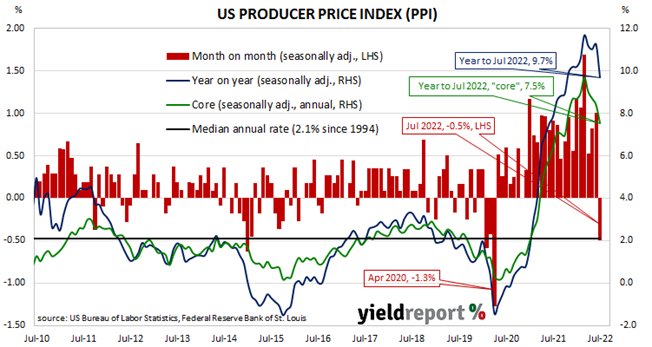Summary: US producer price index (PPI) down 0.1% in August, less than expected figure; annual rate slows to 8.7%; “core” PPI up 0.4%; underlying PPI data does not allay fears of further Fed hikes; short-term US Treasury yields jump, rate-rise expectations firm.
Around the end of 2018, the annual inflation rate of the US producer price index (PPI) began a downtrend which continued through 2019. Months in which producer prices increased suggested the trend may have been coming to an end, only for it to continue, culminating in a plunge in April 2020. Figures returned to “normal” towards the end of that year but annual rates over the past eighteen months have been well above the long-term average.
The latest figures published by the Bureau of Labor Statistics indicate producer prices declined by 0.1% after seasonal adjustments in August. The fall was less than the flat result which had been generally expected but above July’s -0.4% after revisions. On a 12-month basis, the rate of producer price inflation after seasonal adjustments slowed from 9.8% in July to 8.7%.
Producer prices excluding foods and energy, or “core” PPI, rose by 0.4% after seasonal adjustments. The increase was slightly higher than the 0.3% rise which had been generally expected as well as July’s 0.3% rise. The annual rate slowed from July’s revised figure of 7.7% to 7.3%.
“All up, the underlying PPI data did nothing to allay fears that the Fed will need to hike considerably further if it is to meet its inflation mandate,” ANZ economist John Bromhead. “Service prices tend to be sticky in that they take a number of months to change and that suggests the task facing the FOMC is more difficult given price resilience.”
US Treasury bond yields increased on the day, especially so at the short end of the curve. By the close of business, the 2-year Treasury yield had gained 24bps to 3.779%, the 10-year yield had added 12bps to 3.44% while the 30-year yield finished 4bps higher at 3.42%.
In terms of US Fed policy, expectations of higher federal funds rates over the next 12 months firmed. At the close of business, October contracts implied an effective federal funds rate of 3.145%, 82bps higher than the current spot rate. November contracts implied 3.765% while September 2023 futures contracts implied an effective federal funds rate of 4.165%, 184bps above the spot rate.
The producer price index is a measure of prices received by producers for domestically produced goods, services and construction. It is put together in a fashion similar to the consumer price index (CPI) except it measures prices received from the producer’s perspective rather than from the perspective of a retailer or a consumer. It is another one of the various measures of inflation tracked by the US Fed, along with core personal consumption expenditure (PCE) price data.


